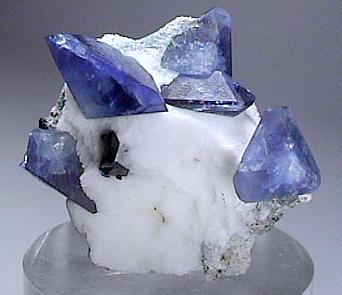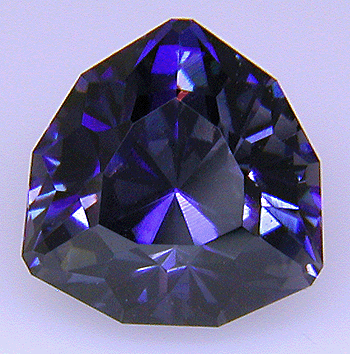| Crystal system | Hexagonal |
| Transparency | Transparent |
| Luster | Vitreous to subadantine |
| Fracture | Conchoidal to Uneven |
| Cleavage | None |
| Specific Gravity | 3.64 |
| Hardness | 6 to 6.5 |
| Optical Character | Uniaxial + ; Double Refractive |
| Refractive index | 1.757-1.804 |
| Birefringence | 0.047 |
| Dispersion | 0.044 |
| Fluorescence | Light blue. |
| Pleochroism | Strong; Blue stones: Colorless & blue; Purple & violet stones: reddish grey. |
| Chemical Formula | BaTiSi3O9 |
| Comments | |
| Streak | |
Benitoite (be-NEE-toe-ite) is interesting and unique from a number of viewpoints. It is one of the more recently discovered gem minerals, having been found in (and named after) San Benito County, California, in 1907. This locality was for years the only one from which this species was taken. Another deposit was discovered in the 1960's in central California. Shortly after the discovery, it is said that the discoverer and first miner of the deposit offered the stones to a number of famous jewelry stores, prominent among which was Tiffany & Company. Tiffany is rumored to have offered to handle the stone on an exclusive basis and to lend the weight of their prestige to publicizing and popularizing it. However, feeling that the potential would be greater if it were offered to many, the exploiter soon found that he was unable to make the venture a commercial success.
The mineral is also interesting from a crystallographic viewpoint. Many years ago, three mathematicians almost simultaneously reached the conclusion that there could be 230 different arrangements of atoms in space that would be capable of the indefinite repetition necessary to form a crystal. These 230 space groups have been further classified into the six crystal systems. One of these arrangements which had never been encountered in nature was the trigonal bipyramid class of the hexagonal system. It was not until the discovery of benitoite that this theoretical pattern was found to exist; in other words, benitoite was the first example of that crystal structure.
Benitoite occurs in transparent, light to dark blue colors, reminiscent of sapphire. On occasion, it is also colorless or light violet to purple; more often, the latter is merely a blue color that seems to have a violet tinge. Recently, a pink variety was identified. The largest cut blue stone of fine quality discovered to date weighs only seven carats.
In the San Benito County locality, benitoite is found with the rare mineral neptunite in narrow veinlets of natrolite in the Mt. Diablo Range. The only other occurrence known for neptunite is in Greenland. The original working of the deposit was made in the belief that the stones were sapphires. When this was soon found to be incorrect, the operation continued for a time, but only since World War II has it been reopened and apparently worked out. The second deposit is worked spasmodically.
The chemical composition of benitoite is BaTiSi309, a barium-titanium silicate. The blue color is apparently caused by titanium. It has a hardness of 6 to 6 1/2 and rather poor toughness, despite a lack of cleavage; the fracture is conchoidal to uneven. The specific gravity is usually within .03 of 3.64, and the streak is white. There are no characteristic inclusions. A refractive index of 1.757 - 1.804 gives a birefringence of .047, which is very strong. The luster is vitreous to sub-adamantine, and the optic character is uniaxial positive. It is very strongly pleochroic, varying from colorless or very pale blue in one vibration direction to very dark blue in the other. Violet and purple stones have a purple-violet and reddish-gray dichroism. With a value of .004, the dispersion is equal to that of diamond. No phenomena are exhibited. It fuses before the jeweler's torch and is attacked by acids.
Benitoite is rather readily identified because of its very high birefringence at this point on the refractometer scale. Because it is positive in sign and the high index is almost off the scale, often only the 1.757 index is seen and is thus mistaken for sapphire. A reading taken in white light may appear to be 1.76 and thus be accepted by the novice tester as the reading for sapphire without further checking. Examination under magnification will show very strong doubling for benitoite, in contrast to sapphire. In addition, the pleochroism is "wrong" and the dispersion is much too high for sapphire. The only other stones likely to cause confusion are blue spinel and glass; either, however, can be separated with the polariscope or dichroscope, since they are singly refractive.
The most commonly used cutting style is the round brilliant; the cabochon form is rarely used. It is not sensitive to the heat generated by any phase of the fashioning operation nor does cleavage present a problem; therefore, only the usual precautions are necessary. To produce the most attractive stone, the crystal must be oriented carefully for the best color. Because of its low hardness, it grinds away rapidly. Polishing is accomplished on a tin lap with Linde A or on a lucite lap with cerium oxide. A crown angle of 37° and a pavilion angle of 42° prove satisfactory.



